Day 19: Rovinj, Postonja Caves, and Ljubljana Slovenia
Feeling better this morning we had a nice tour of the town of Rovinj.
Rovinj, built on an island close to the coast, became connected to the mainland by filling in the channel only in 1763. From 1283 to 1797, Rovinj was one of the most important towns in Istria governed by the Republic of Venice. During this period, three town gates were constructed and Rovinj was fortified by two rows of defensive walls, remains of which can still be seen today. The Rovinj pier is home to one of the old town gates, Balbi's Arch, dating from 1680, and a late-Renaissance clock tower
 |
| Rovinj main square and clock tower |
 |
| The Balbi Arch |
 |
| Remnants of the old city wall |
On the highest point of land on the peninsula stands the Basilica of St. Euphemia, built from 1725 to 1736, over the remains of older, early Christian structures.
The dedication was originally to Saint George, later to Saints George and Euphemia; the present building is dedicated to Euphemia only. The relics of Saint Euphemia are preserved in a Roman sarcophagus from the sixth century.
Postojna Cave is home to over 150 animal species, making it a subterranean biodiversity hotspot. These include the olm, also known as the "baby dragon," It is the largest troglodytic amphibian in the world. The tour through the caves includes an aquarium with some olms in it. In 2016, a female olm at the cave began to lay over 50 eggs and twenty-two baby olms successfully hatched.
We sauntered back to the hotel passing through nearby Preseren Square, listening to the street musicians and people watching.
The bell tower resembles the tower of St Mark's Basilica in Venice. This 60 foot tower was built between 1654–1680 and on top stands the statue of Saint Euphemia, serving as a wind vane.
 |
| Shrine to where St. Euphemia's sarcophagus was said to have washed up on shore |
 |
After completing our tour of the old town, we re-embarked our Sprinter for the trip Slovenia and our first stop, the Postonja Caves.
Slovenia has a rich history, with evidence of human habitation dating back 250,000 years. The territory was later inhabited by Celtic and Roman tribes, followed by Slavic migrations. For much of its history, Slovenia was under the rule of various empires, including the Roman, Carolingian, and Habsburg empires. It was part of Italy between the word wars and then became a province of communist Yugoslavia. Slovenia gained independence from Yugoslavia in 1991, becoming a sovereign nation.
As an EU country, crossing the border was a piece of cake, but the trip did have some excitement. Bura winds that confounded us on the boat were again causing problems. The highway that we were planning on taking was closed to busses due to high Bura winds. Our 1 1/2 hr. trip turned into 2 1/2 hour on back roads. Glad Mario was at the helm. We had timed tickets for the cave and fortunately, Mario had left enough time for such eventualities and we made it just in the nick.
The cave system was first described in the 17th century by Johann Weikhard Freiherr von Valvasor but in 1818 the region of the cave we now visit was accidentaly discovered by a local, Luka Čeč, while preparing for a visit by the Austro-Hungarian Emperor Francis I. In 1819, Archduke Ferdinand visited the caves, this is when the caves became officially known as a tourist destination. Čeč became the first official tourist guide for the caves when the caves were opened to the public. Electric lighting was added in 1884,.
During WWII the caves were coopted by the invading German forces and were used to store 1,000 barrels of aircraft fuel, which were destroyed in April 1944 by Slovene Partisans. The fire burned for seven days, destroying a large section of the cave and blackening the entrance.
Tourists have access to about 3.5 miles of the cave system. To improve accessibility, an train moves visitors from the entrance deep into the cave. In 1872, cave rails were laid along with first cave train for tourists. At first, these were pushed along by the guides themselves, later at the beginning of the 20th century a gas locomotive was introduced, and finally in 1945, converted to much more friendly electric engine.
The train ride took about 10 or 15 minutes and was very Disneyesque. The train sped in sharp curves around stalagmites and stalactites, and at times, we felt (especially the Daves- not the rest of us who are vertically challenged) nthe need to duck to avoid low ceilings. At the end of the rail line, we disembarked and then walked for about an hour deep in the cavern. Temperatures in the caves are always 50° F. Luckily, Rich ad Suzy had forewarned us, and we brought multiple layers. Even so, on the return train ride to the surface, I was freezing.
Postojna Cave is home to over 150 animal species, making it a subterranean biodiversity hotspot. These include the olm, also known as the "baby dragon," It is the largest troglodytic amphibian in the world. The tour through the caves includes an aquarium with some olms in it. In 2016, a female olm at the cave began to lay over 50 eggs and twenty-two baby olms successfully hatched.
The last leg of our journey brought us to Ljubljana, the capital of Slovenia. Ljubljana's history stretches back to Roman times with the settlement of Emona. It was taken over by the Slavic Slovenes and renamed Luvigana.
By the time we reached our hotel, we were starved and found a nice place to eat at the foot of one of many bridges that span the Ljubljanica River. All the bridges are named, this one was the Butcher's Bridge because this was where the butchers sold their wares. It is now adorned with some pretty weird statuary from the Slovenian artist, Jakov Brdar.
After dinner, we wandered across the bridge and along the river to the iconic "Dragon Bridge". The bridge is a unique creation considered to be an extraordinary piece of technical heritage and a superb example of Art Nouveau architecture, which flourished at the turn of the 20th century. Constructed between 1900 and 1901, it was Ljubljana's first reinforced concrete structure and one of the largest bridges of its kind to be built in Europe. The city's symbol is the Ljubljana Dragon. It is depicted on the top of the tower of Ljubljana Castle in the Ljubljana coat of arms as well as the bridge. It represents power, courage, and greatness.
We sauntered back to the hotel passing through nearby Preseren Square, listening to the street musicians and people watching.
 |
| Franciscan Church in Preseren Sq. |
 |
| Our hotel, Eurostar Grand Hotel Union |
tomorrow is our last day of the trip. Where did the time go?





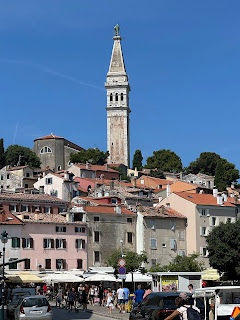
















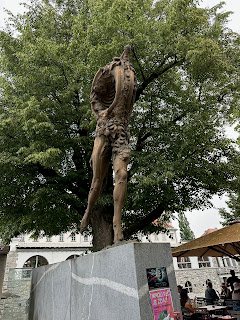
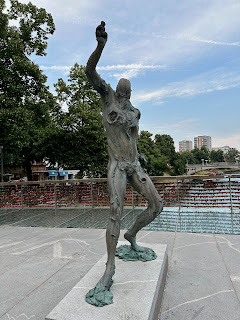
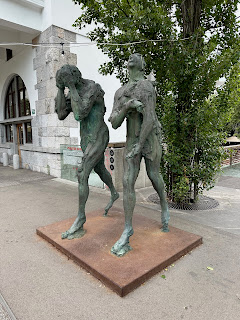


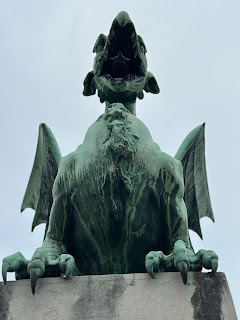


No comments:
Post a Comment